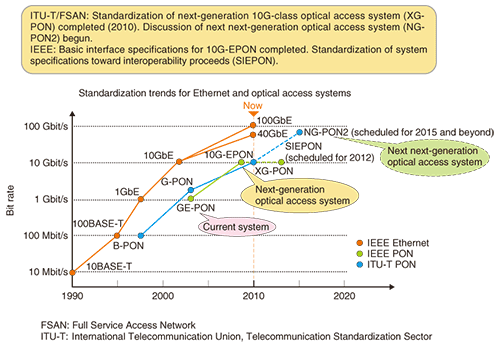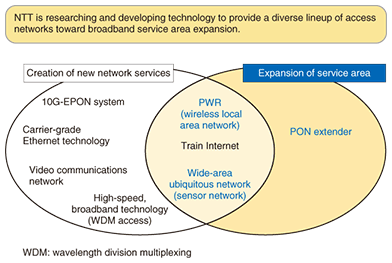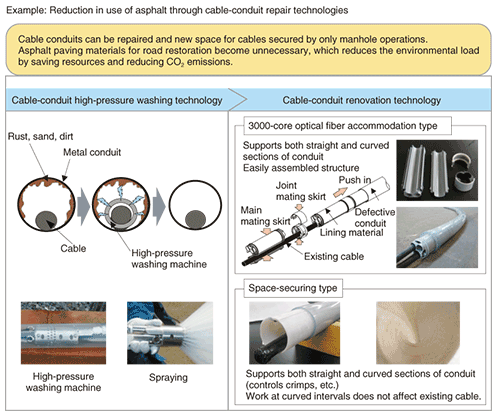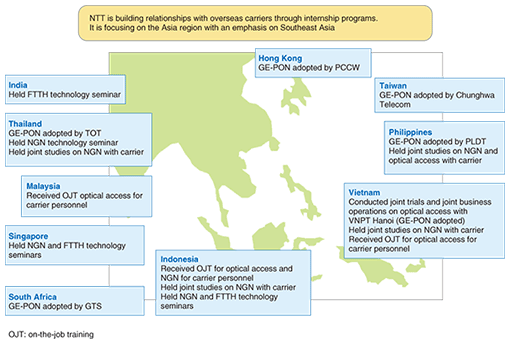 |
|||
|
|
|||
|
Feature Articles: NTT Tsukuba Forum 2010 Workshop Lectures Vol. 9, No. 5, pp. 16–22, May 2011. https://doi.org/10.53829/ntr201105fa2 R&D toward “Access Networks––Building Trust, Connecting People” AbstractResearchers at NTT Access Network Service Systems Laboratories are engaged in research and development of the access network under the theme of building trust and connecting people. This article describes the current state of the access network and associated issues and introduces the five main approaches at NTT Access Network Service Systems Laboratories. The Feature Articles in this month’s issue are based on lectures given at the NTT Tsukuba Forum 2010 workshop held on October 21, 2010.
1. R&D at NTT Access Network Service Systems LaboratoriesAt NTT Access Network Service Systems Laboratories, we are involved in the following four fields of research and development (R&D): (1) Optical access network technology to provide high-speed, diverse, and inexpensive communication services by optical access (2) Wireless access technology to provide high-speed, broadband, and seamless communication services to diverse locations and areas by wireless access (3) Media network technology to achieve an economical access network, rapid service provision, and efficient operation of facilities (4) Infrastructure technology to achieve long-lasting and efficient use of primary communication facilities such as conduits and manholes In short, NTT Access Network Service Systems Laboratories deals with a wide array of technologies for making connections from NTT central offices to users’ households. 2. Trends surrounding the access systemAs of the end of June 2010, the number of subscribers to broadband services in Japan had risen to 33,550,000. Among these, subscribers to fiber-to-the-home (FTTH) access accounted for 18,570,000 or 55% of the total. In terms of national broadband penetration (total number of subscribers divided by population of the country), these figures mean that Japan comes in second behind Korea, but in terms of total number of subscribers, they indicate that Japan occupies first place, far ahead of other countries, reflecting its commitment to increasing the penetration of FTTH and being a world leader in this field. Within the NTT Group, the number of FTTH subscribers as of the end of June 2010 came to 13,840,000 for NTT EAST and NTT WEST combined. This figure is forecast to exceed 15 million by the end of fiscal year 2010. Needless to say, the NTT Group is not just aiming to increase the number of subscribers—it is also working to increase high-speed and advanced services so that even better products can be provided. When they were first deployed, FTTH services had a maximum transmission speed of only 10 Mbit/s. Now, up to 100 Mbit/s is normal, and since 2009, services with a maximum transmission speed of 200 Mbit/s or even 1 Gbit/s have been available. It is also important for social issues such as the aging society and changes in the global environment to taken into account when new technology for the access network is being developed. An aging society means a decrease in the working population. Japan’s workforce in 2010 made up 63.9% of the population, but from here on, it is expected to drop by 5 points every 20 years. NTT is not exempt from this problem: the aging of its employees is also a major issue. For NTT, this makes it all the more urgent to develop do-it-yourself (DIY) facilities, simplify installation work, and make maintenance work more efficient. At present, the amount of human-induced CO2 discharge is more than double the amount that can be naturally absorbed. The effects of global warming such as rising sea levels and desertification are of serious concern, prompting NTT to actively promote measures to protect the environment. Access-system equipment and components are used in the section up to the user’s home and even inside the home, and in addition to being deployed in great quantities, they tend to be quite diverse in makeup in line with the diversification of services. Reducing the power and resource consumption of these products can therefore have a major effect toward preserving the environment. 3. Access network R&D activitiesOn the basis of the following external trends, NTT Access Network Service Systems Laboratories is taking up the following challenges in developing technology for the access network:
To achieve the above, we are undertaking five specific measures, which are discussed below: constructing a high-reliability and economical network, creating new network services, expanding the broadband service area, promoting green R&D, and expanding globally. 3.1 Constructing a highly reliable and economical networkTo reduce capital expenditure (CAPEX), we are working to optimize aggregation appropriate to user dispersion, construct facilities applicable to rural areas, promote the use of existing facilities, and simplify the work of installing new circuits and deploying new services. We are also working to reduce operating expenditure (OPEX) in relation to maintenance/operations and fault repair. Here, to supplement operations support technology based on existing operations systems, our plan is to simplify installation work through DIY facilities and skill-free procedures and introduce technology like remote fault troubleshooting and remote switching to make maintenance operations even more efficient. At the same time, we are working to make network facilities more reliable and to achieve long-life infrastructure facilities. The three technologies described below reflect these expenditure-reducing efforts. (1) Small-diameter, low-friction indoor optical fiber cable To promote the provision of optical services in multi-dwelling units and especially in existing structures, it became necessary to lay many cables using the spare space in existing conduits that already house telephone cables. In response to this need, we developed a small-diameter, low-friction indoor optical fiber cable having half the cross-sectional area and one-fifth the dynamic friction coefficient of existing products. More than 20 of these new cables can be deployed in the free space in existing conduits compared with only a few cables of the current type. Thus, optical services that could not be provided in the past owing to insufficient space in conduits can now be offered. This newly developed cable was also given an optimal amount of bending rigidity so that it could be installed in the conduit using the push-in method instead of the conventional pulling method using a pulling wire. The end result was a reduction in cable deployment time. (2) Optical-media maintenance and operations technology (traffic monitoring tool) We developed a traffic monitoring tool for monitoring signals from an optical network unit (ONU) and displaying service status. This tool enables on-site personnel to check the link status between optical fibers and an ONU. With this tool, the user’s usage conditions can be checked in real time and the media access control (MAC) address can be verified when fibers are switched to ensure that the user has been connected. This prevents erroneous cutoffs or connections in fiber switching activities while also reducing installation time. (3) Operations visualization technology This technology aims to make operations more efficient and improve security by systematizing business know-how possessed by individual employees. This know-how can be extracted from work logs that record the daily actions of operators and accumulated in a database so that it can be reflected in future operations. We can compare this approach to a high-performance car navigation system that uses a record of routes travelled by veteran drivers to advise novice drivers which roads to take or to guide a driver along an optimal route by means of an auto-cruise (auto-pilot) function. Although this function could have been achieved in the past by embedding it in the system, the advantage of this technology is that information from work logs can be collected without having to revamp the base operations system. In this way, we aim to achieve functions such as automatic execution of routine operations, operation navigation, and controls on certain operations. 3.2 Creating new network servicesNTT Access Network Service Systems Laboratories is researching and developing a high-reliability, next-generation access network to promote the creation of new network services. 3.2.1 10G-EPONThe demand for a faster optical access network is growing as broadband services spread and the Next Generation Network (NGN) expands. The standardization of optical access systems tends to lag behind the Ethernet standardization process by a few years (Fig. 1). The GE-PON (Gigabit Ethernet passive optical network) optical access system, which is the one now in use, was standardized in 2004, while specifications for the physical layer and data-link layer of 10G-EPON (10-Gbit/s Ethernet PON) were standardized in 2009. In addition, discussions on NG-PON2 as the next next-generation optical access system providing several tens of gigabits per second have already begun.
At present, work is proceeding on standardizing interoperability between GE-PON and 10G-EPON at the system and network levels. Coexistence with the current GE-PON system is essential to the adoption and expansion of 10G-EPON. We are studying a system that has a 1G-10G dual-rate optical line terminal (OLT) to accommodate GE-PON ONUs (1G upstream, 1G downstream) and 10G-EPON ONUs (1G or 10G upstream, 10G downstream) connected to the same splitter. Such interoperability will enable users who desire faster speeds to migrate to new services smoothly. 3.2.2 Carrier-grade Ethernet technologyTo achieve high reliability, maintainability, and operability, we are developing the following three network technologies as well as an operations system that can implement those technologies and applying them to commercial services (NTT’s Business Ether Wide). (1) Ethernet OAM technology: Generates maintenance signals in communication circuits so that faults can be discovered in real time and troubleshooting performed immediately (OAM: operations, administration, and maintenance). (2) Ethernet ring protection technology: Prevents collisions from occurring during ring-switching at the time of a fault in a ring-based network. (3) Redundant access technology: Duplicates circuits in the access interval and performs high-speed switching at the time of a fault to improve reliability. 3.3 Expanding the broadband service areaNTT Access Network Service Systems Laboratories is working to expand the broadband service area by providing a diverse lineup of access networks. There are many technologies that can link the creation of new network services with the expansion of the service area (Fig. 2).
3.3.1 Optical-amplification PON repeater (PON extender)The maximum transmission distance of the current PON system is 20 km, which means that some sort of distance-extending technology is needed to provide services to rural areas. In response to this need, we are developing a PON repeater to achieve wide-area service coverage (with long-distance, multi-branching capabilities) through optical amplification. This repeater can be installed outdoors on poles so that transmission distances can be increased in rural areas and the number of branches and accommodated ONUs can be increased in urban areas. 3.3.2 Wireless technologyA personal wireless router (PWR) will enable a variety of devices equipped with wireless local area network functions to be automatically connected to the most optimal network (3G, Wi-Fi, optical access, etc.) without user intervention. A wide-area ubiquitous network (sensor network) will make possible services for automatically collecting information over a wide area by attaching wireless terminals to all kinds of things. Various service concepts are now being studied: one application would be to enable gas and electricity meters to be read wirelessly from an office instead of visually by a person in the field. 3.4 Promoting green R&D3.4.1 Activities toward preserving the global environmentAt NTT Access Network Service Systems Laboratories, our R&D efforts follow the “NTT Group Energy Efficiency Guidelines” conforming to the “ICT Ecology Guidelines” established by the Telecommunications Carriers Association (ICT: information and communications technology). We are working to reduce power consumption in access-network equipment by steering our long-term research in the following three directions. - Reduce power in devices and components - Reduce power through a method/system approach - Reduce power through a network-architecture approach We are also developing cable-conduit repair technology, design technology for concrete poles, and optical-splitter compact housing technology to save resources including recycling access-network facilities. 3.4.2 Power-savings technology for PON systemsTo reduce power consumption in the access network, we are researching the application of mechanisms like automobile idle-stop systems to PON systems. A sleep function will deactivate some ONU functions according to current operating conditions and a link-rate switching function will switch the link rate between OLT and ONU according to current traffic conditions. Achieving these mechanisms will require protocol for controlling communications between the OLT and ONU, and standardization activities to this end are proceeding. 3.4.3 Resource savings by cable-conduit repair technologiesThese technologies make it possible to repair cable conduits though operations performed only in a manhole. This enables conduits to be reused while also reducing the use of asphalt conventionally required in cable-conduit excavation work and cutting down on earth, sand, and other waste (Fig. 3). Cable-conduit high-pressure washing technology removes rust and dirt inside a conduit by high-pressure washing without requiring the cable to be pulled out. Cable-conduit renovation technology secures space for accommodating additional cables by inserting lining material inside a conduit after it has been washed.
Up to now, the repair of a degraded conduit required excavation of the road surface, backfilling after completion of the repair, and the application of a new asphalt coating. Our new no-dig technologies, however, eliminate the need for roadwork to excavate and repair conduit cables. Once these technologies are fully implemented, the use of asphalt paving materials is forecast to drop by about 300,000 tons over a five-year period. 3.5 Expanding globallyTo become more competitive on the world stage, NTT is actively promoting its researched and developed technologies and their products to a number of countries overseas. It is also involved in international standardization activities and relationship building with an eye to expanding business on a global scale. Three specific R&D achievements of NTT Access Network Service Systems Laboratories are contributing to the global expansion of the Japanese ICT industry. (1) Free-bending optical fiber cord and small-diameter, low-friction indoor optical fiber cable: NTT was the first in the world to commercialize these products, which are now being sold overseas by Japanese manufacturers. (2) Optical connectors: These have been internationally standardized (by IEC: International Electrotechnical Commission) and hold a world share of about 50%. (3) High-speed optical access system (GE-PON): This system has been internationally standardized (by IEEE) and adopted by Chunghwa Telecom (Taiwan), TOT (Thailand), PCCW (Hong Kong), and other overseas carriers. In addition to providing technologies and products, NTT is also building relationships with overseas telecommunication carriers by receiving interns and holding technology seminars (Fig. 4). The initial focus here was Southeast Asia, but tie-ups with carriers in Central and South America have recently begun.
4. ConclusionUnder the theme of building trust and connecting people, NTT Access Network Service Systems Laboratories will continue to research and develop technology toward achieving a sophisticated communication environment and a safe, secure, and reliable information sharing environment for the betterment of society. ProfileCareer highlightsExecutive Manager, Senior Research Engineer, Supervisor, Access Service and Network Architecture Project, NTT Access Network Service Systems Laboratories. Yukio Akiyama received the M.S. degree in mathematics from Hokkaido University in 1987. After joining NTT in 1987, he engaged in research on operations support systems for the access network, failure analysis of LANs, huge data analysis, and R&D product promotion. He is now engaged in strategy planning of access network R&D and research on the architecture of operations systems. He is a member of the Information Processing Society of Japan and the Japanese Society for Artificial Intelligence. |
|||











